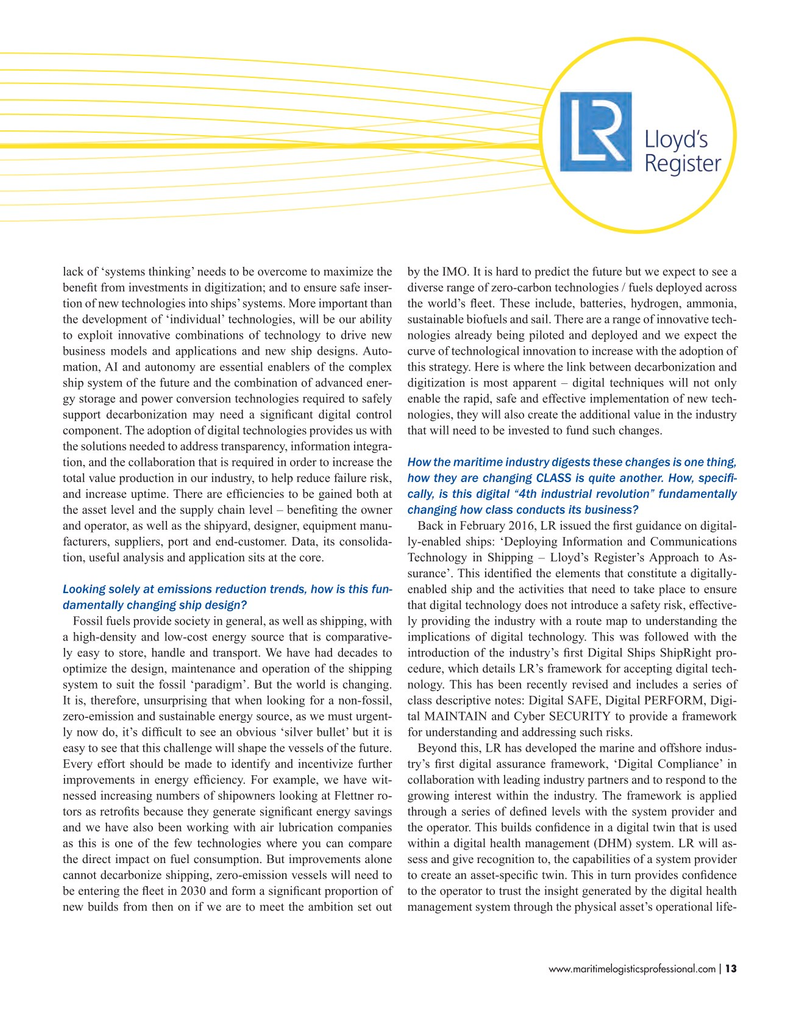
Page 13: of Maritime Logistics Professional Magazine (Sep/Oct 2018)
Liner Shipping & Logistics
Read this page in Pdf, Flash or Html5 edition of Sep/Oct 2018 Maritime Logistics Professional Magazine
lack of ‘systems thinking’ needs to be overcome to maximize the by the IMO. It is hard to predict the future but we expect to see a beneft from investments in digitization; and to ensure safe inser- diverse range of zero-carbon technologies / fuels deployed across tion of new technologies into ships’ systems. More important than the world’s feet. These include, batteries, hydrogen, ammonia, the development of ‘individual’ technologies, will be our ability sustainable biofuels and sail. There are a range of innovative tech- to exploit innovative combinations of technology to drive new nologies already being piloted and deployed and we expect the business models and applications and new ship designs. Auto- curve of technological innovation to increase with the adoption of mation, AI and autonomy are essential enablers of the complex this strategy. Here is where the link between decarbonization and ship system of the future and the combination of advanced ener- digitization is most apparent – digital techniques will not only gy storage and power conversion technologies required to safely enable the rapid, safe and effective implementation of new tech- support decarbonization may need a signifcant digital control nologies, they will also create the additional value in the industry component. The adoption of digital technologies provides us with that will need to be invested to fund such changes.
the solutions needed to address transparency, information integra- tion, and the collaboration that is required in order to increase the How the maritime industry digests these changes is one thing, total value production in our industry, to help reduce failure risk, how they are changing CLASS is quite another. How, specif- and increase uptime. There are effciencies to be gained both at cally, is this digital “4th industrial revolution” fundamentally the asset level and the supply chain level – benefting the owner changing how class conducts its business?
and operator, as well as the shipyard, designer, equipment manu- Back in February 2016, LR issued the frst guidance on digital- facturers, suppliers, port and end-customer. Data, its consolida- ly-enabled ships: ‘Deploying Information and Communications tion, useful analysis and application sits at the core. Technology in Shipping – Lloyd’s Register’s Approach to As- surance’. This identifed the elements that constitute a digitally-
Looking solely at emissions reduction trends, how is this fun- enabled ship and the activities that need to take place to ensure damentally changing ship design? that digital technology does not introduce a safety risk, effective-
Fossil fuels provide society in general, as well as shipping, with ly providing the industry with a route map to understanding the a high-density and low-cost energy source that is comparative- implications of digital technology. This was followed with the ly easy to store, handle and transport. We have had decades to introduction of the industry’s frst Digital Ships ShipRight pro- optimize the design, maintenance and operation of the shipping cedure, which details LR’s framework for accepting digital tech- system to suit the fossil ‘paradigm’. But the world is changing. nology. This has been recently revised and includes a series of
It is, therefore, unsurprising that when looking for a non-fossil, class descriptive notes: Digital SAFE, Digital PERFORM, Digi- zero-emission and sustainable energy source, as we must urgent- tal MAINTAIN and Cyber SECURITY to provide a framework ly now do, it’s diffcult to see an obvious ‘silver bullet’ but it is for understanding and addressing such risks.
easy to see that this challenge will shape the vessels of the future. Beyond this, LR has developed the marine and offshore indus-
Every effort should be made to identify and incentivize further try’s frst digital assurance framework, ‘Digital Compliance’ in improvements in energy effciency. For example, we have wit- collaboration with leading industry partners and to respond to the nessed increasing numbers of shipowners looking at Flettner ro- growing interest within the industry. The framework is applied tors as retrofts because they generate signifcant energy savings through a series of defned levels with the system provider and and we have also been working with air lubrication companies the operator. This builds confdence in a digital twin that is used as this is one of the few technologies where you can compare within a digital health management (DHM) system. LR will as- the direct impact on fuel consumption. But improvements alone sess and give recognition to, the capabilities of a system provider cannot decarbonize shipping, zero-emission vessels will need to to create an asset-specifc twin. This in turn provides confdence be entering the feet in 2030 and form a signifcant proportion of to the operator to trust the insight generated by the digital health new builds from then on if we are to meet the ambition set out management system through the physical asset’s operational life- www.maritimelogisticsprofessional.com 13
I

 12
12

 14
14
